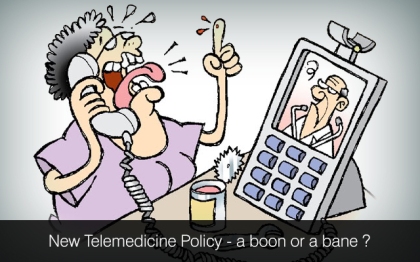Disregarding previous recommendations of the American Telemedicine Association, representatives of Federation State Medical Boards (FSMB) has approved new guidelines for the use of telemedicine without making any further changes. Federation State Medical Boards (FSMB) said in an announcement that the Model Policy on proper Use of Telemedicine Technologies within the Practice of Medicine, implemented from the Federation of State Medical Boards (FSMB), offers necessary guidance as well as a road-map which state boards may use to make sure that patients are protected against harm in a fast-changing healthcare delivery environment.
 Dr. Humayun J. Chaudhry, Managing Director, President and Chief Executive Officer of FSMB said telemedicine provides great tools to help increase treatment solutions for the patients, especially in providing care in remote areas, reducing costs and assisting support preventive care efforts. However since telemedicine has expanded, that also, have the necessity for clean, common-sense rules which help healthcare providers switch to the interesting new situation in the safe way. The latest guidelines are made to give doctors freedom in use of technology like telephone, email interactions and videoconferencing, provided they follow the well known standards of patient care, Dr. Chaudhry stated.
Dr. Humayun J. Chaudhry, Managing Director, President and Chief Executive Officer of FSMB said telemedicine provides great tools to help increase treatment solutions for the patients, especially in providing care in remote areas, reducing costs and assisting support preventive care efforts. However since telemedicine has expanded, that also, have the necessity for clean, common-sense rules which help healthcare providers switch to the interesting new situation in the safe way. The latest guidelines are made to give doctors freedom in use of technology like telephone, email interactions and videoconferencing, provided they follow the well known standards of patient care, Dr. Chaudhry stated.
Amongst its main provisions, the model policy mentions that the similar standards of care which have traditionally protected patients while in-person medical encounters should apply to medical care provided electronically. Care providers working with telemedicine should set up an excellent “patient-physician relationship,” making sure that patients are well examined and treated which providers follow strong principles guiding privacy and security of personal health information, informed consent, safe prescribing along with other key aspects of medical practice.
Roy Schoenberg, MD, Chief Executive Officer at American Well praised the Federation of State Medical Boards (FSMB) and said this policy is really a strong move to a the fact in which all patients can have access to quality care regardless of duration, place or location. Since the Federation did its job as leaders, we expect states to carry out the same – accept this model policy, and thus make sure just safe, secure and appropriate care could be delivered with current telehealth technologies, he stated. And Randy Parker, Chief Executive Officer at MDLive stated in an article in Medscape Medical News , that a standardizing telemedicine policies throughout is an positive move.
ATA contends the policy, moreover it has set the bar raised for telemedicine, even the policy aims in creating a telemedicine visit comparable to that of an in-person consult. Although the policy aims in creating a telemedicine visit comparable to that of an in-person consult, the ATA contends the policy rather it sets the bar raised for telemedicine. ATA objected on necessity that of physicians get licensed within the same state in which the patient is based. It had asked for changes in the policy, along with the description of telemedicine being a videoconferencing or store-forward technology and would like to include telephone and email consults too. From the Center for the Telehealth and e-Health Law (CTEL), that represents most of the nation’s top telemedicine providers, Greg Billings, Executive Director, stated that CTEL appreciates the FSMB’s guideline attempts as an initial step to help put a meaning to safe telemedicine.
Lets have a glance of the policy – standards of care which safeguard patients while in-person medical interactions relate similarly to medical care offered electronically. Providers with telemedicine must set up a very good “patient-physician relationship” and make sure their patients are appropriately evaluated and treated. Providers must follow strong principles guiding confidentiality and safety of records, informed consent, safe prescribing along with other crucial aspects of medical practice. Healthcare software development teams can help you build projects within allocated budgets and time schedules.
We develop medical billing software. If you would like to hire healthcare software developers from us, we would be glad to assist you at Mindfire Solutions.

